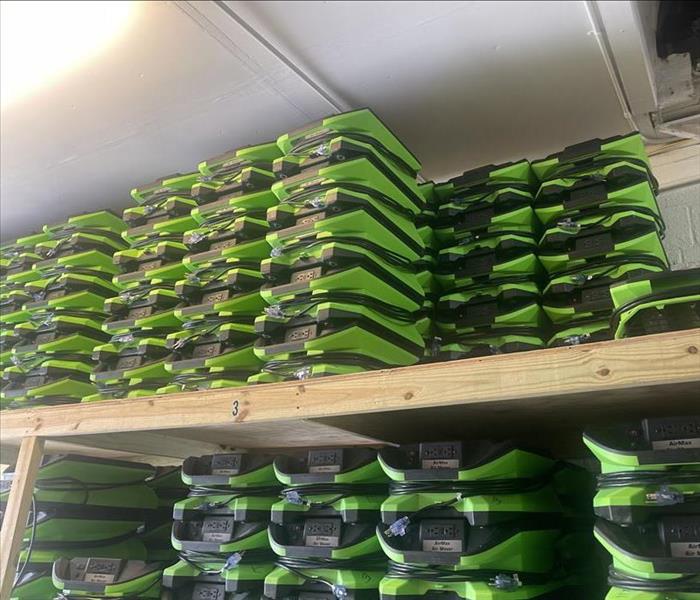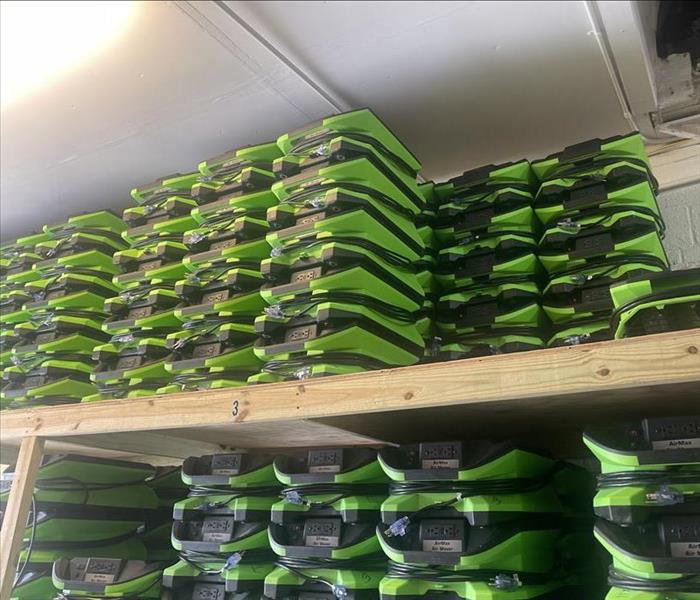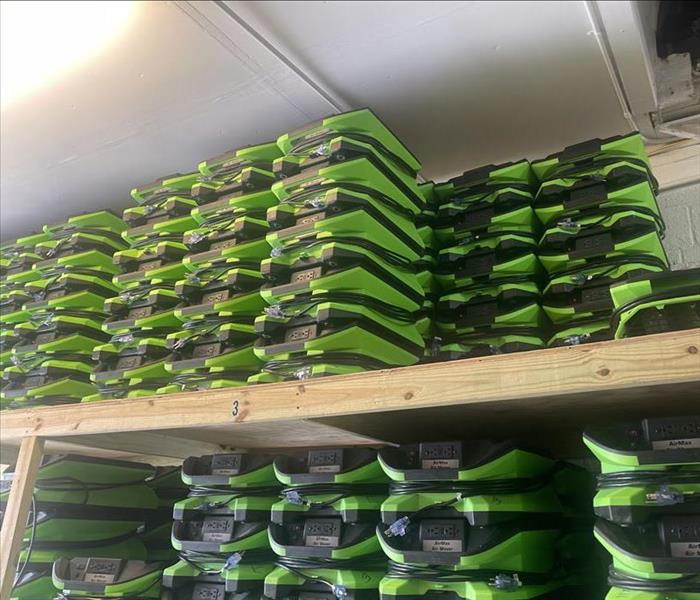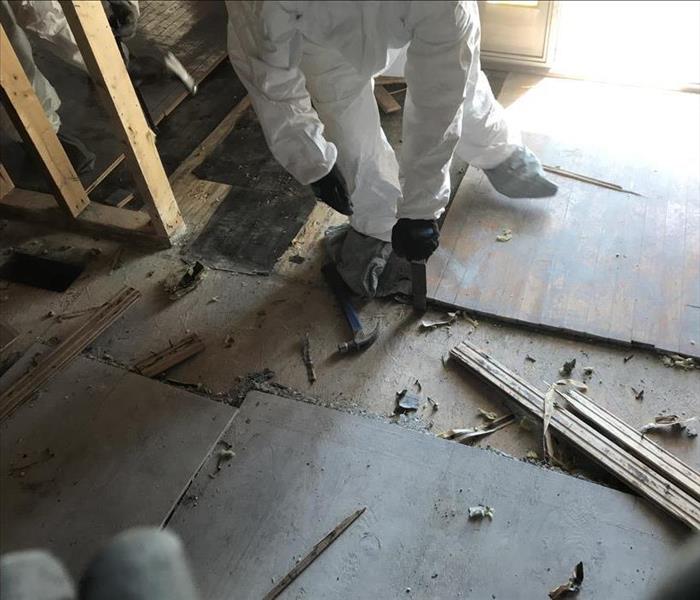Recent Posts
Types of fire-resistant home construction
12/11/2024 (Permalink)
 For more expert advice on fire prevention and restoration services, contact SERVPRO of Southwest Raleigh/Holly Springs.
For more expert advice on fire prevention and restoration services, contact SERVPRO of Southwest Raleigh/Holly Springs.
When constructing a home, fire safety is an important factor that homeowners should consider. Building with fire-resistant materials can significantly reduce the risk of fire damage and protect your property. In fact, according to the Insurance Information Institute (III), homes with fire-resistant construction can lower the risk of damage by up to 40%. Here, we’ll explore the top fire-resistant materials and methods that can help create a safer home.
Fire-Resistant Roofing Materials
Your roof is one of the most vulnerable parts of your home when it comes to fires. Choosing fire-resistant roofing materials is crucial for protection. Some of the best options include:
- Metal roofing: Metal is highly resistant to fire and is often rated as a Class A fire-resistant material, offering excellent protection.
- Clay and concrete tiles: These materials are non-combustible and durable, making them an ideal choice for fire-prone areas.
- Asphalt shingles: When treated with fire-retardant chemicals, asphalt shingles can also provide solid fire resistance.
These materials not only help prevent fire spread but also improve the durability and longevity of your home.
Fire-Resistant Siding
The exterior siding of your home plays a key role in its fire resistance. There are several fire-resistant siding materials to consider:
- Brick and stone veneer: Both brick and stone are non-combustible materials that can withstand high temperatures.
- Stucco: A mix of sand, cement, and lime, stucco offers excellent fire resistance and is a popular choice in fire-prone regions.
- Fiber cement siding: Composed of cement, sand, and cellulose fibers, this material resists both fire and termites, offering double protection.
Choosing fire-resistant siding can dramatically lower the risk of fire spreading to the interior of your home.
Fire-Resistant Windows and Doors
Windows and doors are often overlooked, but they are critical in enhancing fire resistance. To prevent fires from entering through windows and doors, consider:
- Tempered glass windows: These are stronger than standard glass and can better withstand heat.
- Metal or fiberglass doors: These materials resist fire better than wood, making them a smart choice for exterior doors.
Incorporating these fire-resistant features into your home’s design can provide enhanced protection against wildfires or accidental fires.
Fire-Resistant Insulation
Insulation is often hidden behind walls, but it plays a significant role in fire resistance. Two excellent fire-resistant insulation materials include:
- Rock wool (mineral wool): Made from molten rock, this insulation is naturally fire-resistant and can withstand temperatures up to 1,800°F.
- Fiberglass insulation: Another non-combustible material, fiberglass insulation won’t burn easily and can help slow the spread of fire.
By utilizing these fire-resistant materials, you can protect your home from the devastating effects of fire. If you’re considering building or renovating, keep fire safety in mind to enhance both the security and value of your home. For more expert advice on fire prevention and restoration services, contact SERVPRO® of Southwest Raleigh/Holly Springs.
Emergency Mold Remediation: What to Do in a Crisis
11/13/2024 (Permalink)
 Don’t wait for mold to spread—contact SERVPRO today for emergency mold remediation assistance!
Don’t wait for mold to spread—contact SERVPRO today for emergency mold remediation assistance!
Mold infestations can escalate quickly, especially after water damage or extreme weather events. If mold growth is not addressed promptly, it can cause significant damage to your property. As a trusted leader in mold remediation, SERVPRO® of Southwest Raleigh/Holly Springs is here to provide expert guidance on handling a mold crisis. Acting fast is crucial in preventing further structural damage and costly repairs. Here's what you should do when faced with an emergency mold situation.
Identify the Source of the Moisture
Mold thrives in damp environments, so the first step is to identify and address the source of the moisture. Whether it’s a leaking roof, burst pipe, or flooding, eliminating the water source is essential. Mold can begin to grow within 24 to 48 hours after moisture exposure, according to the Federal Emergency Management Agency (FEMA).
Inspect areas prone to moisture, such as basements, bathrooms, and around windows. If the water source isn't controlled, mold will continue to spread, making the situation worse.
Contain the Affected Area
Once you’ve identified mold, it’s critical to contain the area to prevent spores from spreading throughout your home. Close off doors and windows, and avoid using your HVAC system, as it can distribute mold spores into other areas. Use plastic sheeting and seal off any openings where air may flow.
Call Mold Remediation Professionals
While some DIY methods might seem effective, mold remediation requires specialized equipment and expertise. SERVPRO of Southwest Raleigh/Holly Springs uses advanced tools like HEPA air scrubbers, dehumidifiers, and antifungal treatments to remove mold and prevent future growth.
Our trained professionals follow industry best practices and adhere to guidelines set by the Institute of Inspection Cleaning and Restoration Certification (IICRC). This ensures your property is restored safely and thoroughly. DIY methods often don’t address the root cause and can leave mold hidden within walls, flooring, or ceilings.
Steps to Take While Waiting for Help
Here’s what you can do before mold remediation experts arrive:
- Turn off fans and air conditioning to reduce the spread of mold spores.
- Remove any standing water if possible.
- Avoid touching or disturbing the mold.
- Stay out of heavily affected areas.
Trust SERVPRO for Mold Remediation
Time is of the essence when it comes to mold. With over 50 years of experience, SERVPRO of Southwest Raleigh/Holly Springs provides fast, reliable mold remediation services to help you recover from mold-related crises. Whether the infestation is small or widespread, our experts are ready to restore your home quickly and efficiently.
Don’t wait for mold to spread—contact SERVPRO today for emergency mold remediation assistance!
Steps to Take When Your Basement Floods
10/16/2024 (Permalink)
 At SERVPRO, we are experts in water damage restoration.
At SERVPRO, we are experts in water damage restoration.
Flooding in your basement can be a stressful and overwhelming experience. Whether caused by heavy rain, a burst pipe, or groundwater seepage, a flooded basement requires immediate attention to minimize damage and restore your home. At SERVPRO®, we understand the urgency of such situations, and we're here to guide you through the essential steps to take when your basement floods.
1. Ensure Safety First
Before doing anything else, prioritize safety. If your basement is flooded, there’s a chance that electrical hazards could be present. If you can safely access your circuit breaker, turn off the electricity to the affected area. If water levels are high or you're unsure of the situation, it’s best to avoid the basement until professionals can assess the risk. Once the electricity is off, you can safely begin addressing the situation.
2. Identify the Source of the Flooding
Understanding the source of the water is crucial to determining the appropriate course of action. Is the flooding due to external factors like heavy rainfall, or is it from an internal source such as a broken pipe or malfunctioning sump pump? Identifying the cause will help you decide whether you can stop the flow of water yourself or if you need to call in professional help immediately.
3. Remove Water and Dry Out the Area
Once it’s safe to do so, start removing the water as quickly as possible. If the flooding is minor, a wet/dry vacuum can be useful for extracting water. For larger floods, you may need to rent a pump or call in a professional water damage restoration company like SERVPRO®. After the water is removed, use fans, dehumidifiers, and open windows to begin drying out the area. The quicker you dry out your basement, the less damage your home will sustain.
4. Salvage What You Can
Not all items in your basement may be salvageable, but it’s important to act quickly to save what you can. Remove any furniture, appliances, and personal items from the waterlogged area. Items made of porous materials like wood, fabric, or paper are especially vulnerable to water damage, so prioritize moving them to a dry area. Once you’ve removed the items, assess what can be cleaned, dried, and restored, and what may need to be discarded.
5. Prevent Future Flooding
After dealing with the immediate crisis, take steps to prevent future basement flooding. Regular maintenance of your home’s drainage systems, such as clearing gutters and downspouts, can help prevent water from entering your basement. You might also consider installing a sump pump or improving your home's foundation drainage system. If you’re unsure of what’s best for your home, a consultation with a professional can provide you with tailored recommendations.
When your basement floods, quick action is essential to minimize damage and restore your home to its original condition. At SERVPRO, we are experts in water damage restoration, and we're here to help you every step of the way. If you need professional assistance, don’t hesitate to reach out to us. We're ready to make it "Like it never even happened."
Flood Barriers and Sandbags: Effective Techniques for Flood Defense
9/11/2024 (Permalink)
 Proactive measures and timely action are essential in minimizing the impact of floods.
Proactive measures and timely action are essential in minimizing the impact of floods.
Flooding is one of the most devastating natural disasters, causing significant damage to homes, businesses, and infrastructure. As a SERVPRO® employee, I've seen firsthand the impact floods can have on communities. Fortunately, there are effective techniques to mitigate flood damage, with flood barriers and sandbags being two of the most reliable methods for flood defense.
Flood Barriers
Flood barriers, also known as flood walls, are specially designed structures that prevent water from entering protected areas. These barriers come in various forms, including temporary and permanent solutions. Temporary flood barriers, such as water-filled barriers or modular systems, are ideal for quick deployment during imminent flood threats. They are lightweight, easy to assemble, and can be placed strategically around homes or properties to divert water flow. Permanent flood barriers, on the other hand, are typically constructed from concrete or steel and offer long-term protection for high-risk areas. These barriers require more planning and investment but provide robust defense against recurrent flooding.
Sandbags
Sandbags are another widely used and effective method for flood control. They are inexpensive, readily available, and can be deployed quickly in emergency situations. Sandbags work by creating a barrier that absorbs and diverts water away from vulnerable areas. When filled with sand or soil, they form a solid wall that can hold back rising floodwaters. To maximize their effectiveness, it’s crucial to stack sandbags properly. Start by placing a plastic sheet or tarp on the ground to act as a moisture barrier. Then, stack the sandbags in a staggered brick pattern, ensuring each bag is tightly packed and overlaps the one below it. This method creates a more stable and impermeable barrier.
While sandbags are effective, they do have limitations. They are labor-intensive to fill, transport, and place, and they can deteriorate over time, especially when exposed to water for extended periods. Additionally, sandbags may not provide a perfect seal, allowing some water to seep through. For these reasons, combining sandbags with other flood defense measures, such as flood barriers or sump pumps, can enhance overall protection.
Preparedness
Preparation is key to effective flood defense. Assessing the flood risk in your area and having a flood defense plan in place can make a significant difference. Consider investing in both temporary and permanent flood barriers if you live in a high-risk area. Keep a stockpile of sandbags and other flood defense materials readily available, and practice deploying them with your family or neighbors to ensure everyone knows what to do when a flood threat arises.
At SERVPRO, we understand the importance of protecting your property from flood damage. By utilizing flood barriers and sandbags effectively, you can reduce the risk of flooding and safeguard your home or business. Remember, proactive measures and timely action are essential in minimizing the impact of floods. If you need assistance with flood preparation or recovery, SERVPRO is here for you.
The benefits of choosing a local fire damage restoration company
8/14/2024 (Permalink)
 For more information about our fire damage restoration services, or to schedule a consultation, contact your local SERVPRO team today.
For more information about our fire damage restoration services, or to schedule a consultation, contact your local SERVPRO team today.
When disaster strikes, the aftermath can be overwhelming. Fire damage, in particular, leaves homeowners and businesses in a state of shock and uncertainty. Choosing the right restoration company is crucial for a seamless recovery process. Here at SERVPRO®, we believe that opting for a local fire damage restoration company offers distinct advantages that can significantly enhance your recovery experience.
Quick Response Time
One of the most critical factors in fire damage restoration is time. The longer soot and smoke residues remain on surfaces, the more damage they cause. A local restoration company can respond swiftly to your emergency. Being nearby means our SERVPRO teams can arrive on the scene quickly, mitigating further damage and starting the restoration process sooner. This rapid response is vital in preserving as much of your property as possible.
Local Expertise and Knowledge
Local fire damage restoration companies possess a deep understanding of the community they serve. This local expertise translates to a better understanding of common building materials, local construction methods, and specific environmental factors that may affect the restoration process. For instance, SERVPRO teams are familiar with the local climate and how it can impact drying times and mold growth, ensuring that your restoration is thorough and tailored to local conditions.
Personalized Service
Choosing a local restoration company means receiving personalized service. At SERVPRO, we pride ourselves on building strong relationships with our clients. As members of the community, our goal is to support our neighbors through challenging times with empathy and dedication. This personal touch can make a significant difference in your restoration experience, providing peace of mind and a sense of trust that your property is in caring hands.
Community Commitment
Local businesses are inherently invested in their communities. By choosing a local fire damage restoration company, you are supporting local jobs and contributing to the local economy. SERVPRO teams are committed to giving back to the communities we serve, participating in local events, and supporting community initiatives. This commitment to the community ensures that we go above and beyond to provide exceptional service.
Knowledge of Local Regulations
Navigating the complexities of fire damage restoration often involves understanding and complying with local regulations and building codes. Local restoration companies are well-versed in these regulations, ensuring that your restoration project meets all legal requirements. This knowledge helps prevent potential delays and additional costs associated with non-compliance.
Access to Local Resources
Local fire damage restoration companies have established relationships with local suppliers and contractors. This network allows for quicker sourcing of materials and the ability to mobilize additional resources as needed. SERVPRO® teams leverage these connections to streamline the restoration process, ensuring that your property is restored efficiently and effectively.
In the aftermath of a fire, choosing a local fire damage restoration company like SERVPRO can provide numerous benefits, from quick response times and local expertise to personalized service and community commitment. Our dedicated teams are here to help you navigate the restoration process with confidence and care. When disaster strikes, trust your local SERVPRO professionals to restore your property and your peace of mind.
For more information about our fire damage restoration services, or to schedule a consultation, contact your local SERVPRO team today.
The Impact of Fire Damage on Insulation: Understanding the Risks and Restoration Needs
8/13/2024 (Permalink)
Insulation plays a crucial role in the energy efficiency, comfort, and safety of a home or building. However, when a fire occurs, the insulation can suffer significant damage, which affects the structural integrity and safety of the property. In this blog, we will explore how fire damage impacts insulation and why it's essential to address these issues promptly with professional restoration services.
How Fire Affects Insulation
Heat Damage: The intense heat from a fire can degrade the physical properties of insulation materials. This degradation reduces the insulation's effectiveness in maintaining temperature and can cause the insulation to lose its structural integrity, making it less effective in energy conservation.
Charred and Compromised Insulation: Insulation materials like fiberglass, foam, and cellulose can become charred when exposed to high temperatures. Charred insulation not only loses its insulating properties but can also become a fire hazard, potentially spreading flames or heat within the building's framework.
Smoke and Soot Contamination: Smoke and soot produced during a fire can contaminate insulation materials. These particles can permeate the insulation, leading to lingering odors and further diminishing the insulation's effectiveness. Soot can also chemically alter the insulation materials, reducing their thermal resistance.
Moisture Retention: Firefighting efforts typically involve the use of water to extinguish the blaze, leading to significant moisture levels in the building. Insulation that becomes wet is not only less effective at insulating but also at risk of mold growth and further damage if not properly dried and treated.
The Risks of Damaged Insulation
Energy Efficiency: Damaged insulation reduces the energy efficiency of a home or building, leading to increased heating and cooling costs. Proper insulation is critical for maintaining comfortable indoor temperatures and reducing the strain on HVAC systems.
Safety Hazards: Compromised insulation can be a safety hazard. Charred materials can pose risks in terms of flammability, and degraded insulation might not effectively contain or resist heat in the event of another fire.
Indoor Air Quality: Insulation that has absorbed smoke, soot, or moisture can impact indoor air quality. Contaminants from these materials can be harmful to health, especially for those with respiratory conditions.
Restoration and Replacement
Assessment by Professionals: After a fire, it is essential to have a professional assessment of the insulation's condition. Experts can determine whether the insulation can be cleaned and restored or if it needs to be replaced entirely.
Professional Cleanup: Professionals, such as those from SERVPRO®, can use advanced techniques to clean soot and smoke residues from insulation, although in some cases, replacement may be necessary.
Replacing Insulation: If the insulation is too damaged to be effectively cleaned, replacement is often the best option. This ensures that the building's insulation is restored to its full functionality, maintaining energy efficiency and safety.
Moisture Control: Proper drying and moisture control are critical to prevent further damage and mold growth. Specialized drying equipment and techniques are used to ensure all moisture is effectively removed.
Fire damage to insulation can have far-reaching effects on the safety, comfort, and efficiency of a home or building. Addressing this damage promptly and thoroughly is essential for restoring the property to its pre-fire condition. Professional restoration services, like those offered by SERVPRO of Harnett County East and Sampson County North are equipped to assess, clean, and replace damaged insulation to ensure that the building remains safe, efficient, and comfortable. If your property has been affected by fire, seeking professional restoration services is crucial for comprehensive recovery.
Mold in New Construction: Prevention and Early Intervention
7/17/2024 (Permalink)
As a homeowner or property manager, one of the last things you want to discover in your new construction is mold. Mold not only damages your property but can lead to costly repairs if left unchecked. That's why it's crucial to understand how mold can occur in new constructions and what steps you can take to prevent it.
Understanding the Causes
Mold thrives in moist and humid environments, making new constructions particularly susceptible during and after the building process. Moisture can be introduced during construction due to rain, high humidity levels, or improper ventilation. Additionally, building materials such as wood, drywall, and insulation provide organic matter for mold to grow on if they become damp.
Prevention Strategies
- Proper Ventilation: Ensure that your construction site has adequate ventilation to allow moisture to escape. This includes using fans and dehumidifiers as needed, especially in areas prone to high humidity levels.
- Waterproofing: Take proactive measures to waterproof your construction, especially in areas susceptible to water intrusion such as basements, crawl spaces, and bathrooms. Use waterproofing materials and sealants to prevent moisture from seeping in.
- Prompt Repairs: Address any leaks or water damage immediately. Even minor leaks can lead to mold growth if left unattended. Inspect plumbing, roofing, and windows regularly for signs of leaks and repair them promptly.
- Proper Drainage: Ensure that the grading around your construction site slopes away from the foundation to prevent water from pooling around the building. Install gutters and downspouts to direct rainwater away from the structure.
- Mold-Resistant Materials: Consider using mold-resistant building materials where appropriate, such as mold-resistant drywall and paint. These materials are designed to inhibit mold growth, providing an added layer of protection.
Early Intervention
Despite taking preventive measures, mold can still occur in new constructions. Early intervention is key to minimizing damage and preventing mold from spreading. Keep an eye out for signs of mold, such as musty odors, discolored walls or ceilings, and visible mold growth.
If you suspect mold in your new construction, don't hesitate to take action. Contact a professional mold remediation company like SERVPRO® to assess the situation and develop a customized plan for mold removal and remediation.
Mold in new construction can be a serious issue if not addressed promptly. By understanding the causes and implementing preventive measures, you can minimize the risk of mold growth in your property. And if mold does occur, early intervention is crucial to prevent further damage. Remember, SERVPRO is here to help with all your mold remediation needs. Don't let mold spoil your new construction—take proactive steps to protect your investment today!
Sustainable Restoration: Materials for Water Damage Restoration
6/13/2024 (Permalink)
 If you're in need of water damage restoration services, don't hesitate and give our SERVPRO of Southwest Raleigh/Holly Springs team a call today!
If you're in need of water damage restoration services, don't hesitate and give our SERVPRO of Southwest Raleigh/Holly Springs team a call today!
In the aftermath of water damage, rebuilding your home is an opportunity to not only restore but also improve its resilience and sustainability. Choosing the right materials for reconstruction can make a significant difference in the long-term durability and environmental impact of your home. In this blog post, we'll explore the importance of selecting sustainable materials for water damage restoration and provide guidance on choosing eco-friendly options that promote both environmental and personal well-being.
Why Choose Sustainable Materials?
When rebuilding after water damage, it's crucial to consider the environmental impact of the materials used. By opting for sustainable materials, homeowners can reduce their carbon footprint, conserve natural resources, and create healthier indoor environments for themselves and their families.
Key Considerations for Choosing Sustainable Materials
Recycled Content
Look for building materials that contain recycled content, such as recycled wood, metal, or plastic. Using recycled materials reduces the demand for virgin resources and diverts waste from landfills. Additionally, recycled content materials often require less energy to manufacture, further reducing their environmental footprint.
Renewable Resources
Choose materials made from renewable resources that can be replenished naturally, such as bamboo, cork, or sustainably harvested wood. These materials have a lower environmental impact compared to non-renewable alternatives and promote the responsible management of forests and ecosystems.
Low VOCs
Volatile organic compounds (VOCs) are chemicals found in many building materials that can off-gas and contribute to indoor air pollution. Opt for materials with low or zero VOC emissions to create a healthier indoor environment for your family. Look for certifications such as GREENGUARD or Cradle to Cradle to ensure that the materials meet strict indoor air quality standards.
Energy Efficiency
Choose energy-efficient materials that help reduce heating and cooling costs and minimize your home's overall energy consumption. Consider installing energy-efficient windows, doors, and insulation to improve thermal performance and reduce energy waste. Additionally, incorporating renewable energy systems such as solar panels can further enhance your home's sustainability and resilience.
Durability and Longevity
Select materials that are durable, long-lasting, and require minimal maintenance to reduce the need for frequent replacements and repairs. Investing in high-quality, resilient materials upfront can save you money in the long run and reduce the environmental impact associated with frequent renovations and replacements.
Examples of Sustainable Materials for Water Damage Restoration
- Recycled-content insulation made from recycled denim or fiberglass
- Bamboo or cork flooring sourced from renewable forests
- Low-VOC paint and finishes for interior walls and ceilings
- Energy-efficient windows and doors with double or triple-glazing
- Sustainable roofing materials such as metal, clay, or recycled rubber
By choosing sustainable materials for water damage restoration, homeowners can contribute to a more environmentally friendly and resilient built environment while creating healthier and more sustainable homes for themselves and future generations. If you're in need of water damage restoration services, don't hesitate and give our SERVPRO of Southwest Raleigh/Holly Springs team a call today!
A Guide to Understanding Wind Damage
5/15/2024 (Permalink)
 Stay informed, stay vigilant, stay safe, and call our team for assistance with property damage.
Stay informed, stay vigilant, stay safe, and call our team for assistance with property damage.
When it comes to natural disasters, wind can be a powerful and destructive force. Understanding the potential effects of wind damage is crucial for homeowners and business owners alike. In this guide, we'll explore the various ways wind damage can impact properties and offer tips on how to prepare for and mitigate its effects.
1. Roof Damage
One of the most common consequences of high winds is roof damage. Strong gusts can lift shingles, tear off roofing materials, and even cause structural damage to the roof deck. Inspect your roof regularly for signs of wear and tear, and reinforce vulnerable areas to minimize the risk of damage during storms.
2. Siding and Exterior Damage
Wind can also wreak havoc on the exterior of buildings, causing siding to become loose, crack, or detach completely. Flying debris propelled by high winds can cause dents, punctures, and other forms of damage to siding materials. Ensure that your siding is securely installed and consider reinforcing it with impact-resistant materials.
3. Windows and Doors
Windows and doors are particularly vulnerable to wind damage, especially during severe storms and hurricanes. High winds can cause windows to shatter, frames to warp, and doors to become misaligned or damaged. Invest in storm shutters or impact-resistant glass to protect your windows and doors from wind-driven debris.
4. Falling Trees and Branches
Strong winds can uproot trees, snap branches, and topple power lines, posing a significant risk to nearby structures. Trim trees and branches regularly to prevent them from falling onto your property during storms. Remove dead or diseased trees that may be more susceptible to wind damage.
5. Structural Integrity
In extreme cases, prolonged exposure to high winds can compromise the structural integrity of buildings, leading to collapse or partial failure. Ensure that your property is built to code and undergoes regular inspections to identify and address any structural vulnerabilities.
6. Water Intrusion
Wind-driven rain can infiltrate buildings through gaps, cracks, and compromised roofing materials, leading to water damage and mold growth. Seal gaps and cracks around windows, doors, and other openings to prevent water intrusion during storms. Maintain your gutters and downspouts to ensure proper drainage away from the building.
7. Mitigation and Preparedness
To minimize the risk of wind damage, it's essential to take proactive measures to prepare your property. Secure outdoor furniture and equipment, reinforce vulnerable areas, and consider installing wind-resistant features such as impact-resistant windows and doors. Develop a comprehensive emergency plan and stay informed about weather forecasts and warnings.
Understanding the potential impact of wind damage is key to protecting your property and ensuring the safety of your family or occupants. By taking proactive measures to reinforce vulnerable areas, mitigate risks, and prepare for emergencies, you can minimize the effects of wind damage and enhance the resilience of your property against future storms. Stay informed, stay vigilant, and stay safe.
Why Removing Insulation After a Fire Is a Good Idea
4/9/2024 (Permalink)
After a fire, the road to restoring your home to its pre-fire condition can be daunting. Among the many tasks involved in the restoration process, one crucial step often overlooked is the removal of insulation. While it may seem like a minor detail, there are several compelling reasons why removing insulation after a fire is essential for achieving comprehensive restoration results. Let's explore in more detail why insulation removal should be a priority after a fire.
1. Smoke and Soot Contamination
Insulation serves as a magnet for smoke and soot particles during a fire. Even if the insulation appears intact on the surface, these contaminants can penetrate deep into its fibers, compromising indoor air quality and posing risks to occupants. The longer contaminated insulation remains in place, the greater the risk of continued exposure to harmful pollutants. By promptly removing contaminated insulation, restoration professionals can eliminate these pollutants and create a safer and healthier living environment for you and your family.
2. Water Damage Mitigation
In addition to smoke and soot contamination, insulation may also be affected by water damage from firefighting efforts. Wet insulation not only loses its effectiveness in regulating temperature but also becomes a breeding ground for mold and mildew. Left unchecked, mold growth can spread rapidly throughout your home, leading to further damage and indoor air quality issues. By removing water-damaged insulation promptly, restoration professionals can mitigate the risk of mold growth and prevent secondary damage to your home's structure.
3. Structural Integrity and Odor Elimination
Fire-damaged insulation can compromise the structural integrity of your home by retaining moisture, harboring mold, and emitting foul odors. Even after the visible signs of fire damage have been addressed, lingering odors can persist if contaminated insulation remains in place. Removing fire-damaged insulation is crucial for restoring your home's structural integrity and eliminating stubborn odors, ensuring that your living space is safe, comfortable, and odor-free.
4. Preventing Future Problems
By removing insulation that has been compromised by smoke, soot, or water damage, you are taking proactive steps to prevent future problems down the line. Mold growth, poor indoor air quality, and structural issues can all arise if contaminated insulation is left in place. By addressing these issues early on through insulation removal, you can mitigate the risk of more extensive damage and costly repairs in the future.
In conclusion, while it may seem like an extra step in the restoration process, replacing the insulation after a fire is essential for achieving thorough and effective restoration results. By eliminating smoke and soot contamination, preventing mold growth, and restoring your home's structural integrity, insulation removal sets the foundation for a successful restoration project. If you've experienced a fire in your home, don't overlook the importance of insulation removal – trust the experts at SERVPRO® to handle the job safely, efficiently, and effectively.
 For more expert advice on fire prevention and restoration services, contact SERVPRO of Southwest Raleigh/Holly Springs.
For more expert advice on fire prevention and restoration services, contact SERVPRO of Southwest Raleigh/Holly Springs.



 24/7 Emergency Service
24/7 Emergency Service





